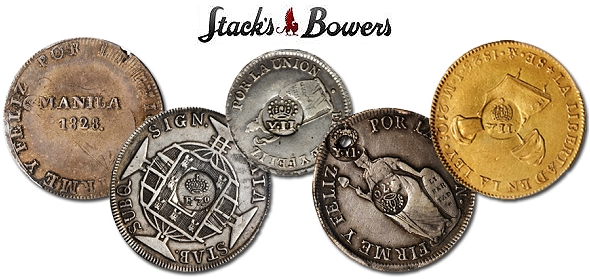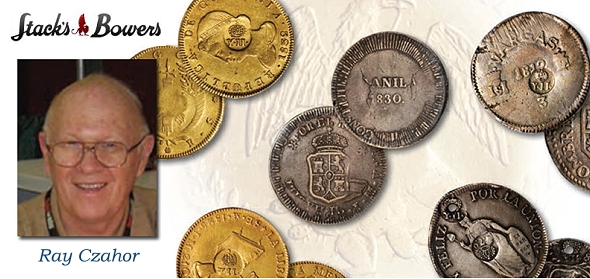
The Ray Czahor Reference Collection of Philippines Countermarks
By Kyle Ponterio – Stack’s Bowers
As the year comes to a close the Stack’s Bowers Galleries NYINC auction is right around the corner. From among the many foreign and ancient coins and banknotes, we take a moment here to spotlight the Philippines section and in particular the collection of Ray Czahor.
The collection of Philippines countermarks assembled by Ray Czahor is the culmination of over 40 years of passion, research and collecting. The vast array of countermark and host coin combinations Ray sought are what makes this series so much fun. The collection features scarce, rare and interesting host coins with minimal duplication. In the beginning of the countermark series you have the 1828 “Manila” and 1830 “Manila” overstrike issues. These were manufactured in a similar fashion to the 960 Reis of Brazil as the authorities completely overstruck the host coins trying to obliterate any and all signs of the original design. Producing these issues ultimately proved to be costly and inefficient with large gaps between production runs.
Lot 1365, 1828 “Manila” on a Cuzco mint 8 Reales. Overstrike is of unusual quality as it is sharply struck with minimal wear, it’s over a scarce host with beautiful toning to boot.
Lot 1368, 1830 “Manila” on a Cuzco mint 8 Reales. Overstrike is over a scarce host and believed to be unique.
The authorities eventually abandoned overstriking for the hand held die containing the King’s cipher “F.7.o”. This new die was more compact and could be applied with a hammer, supposedly to the obverse of insurgent coins, foreign coins and badly worn or mutilated coins. With the implementation of the new countermarks you see a greater variety of host coins, including minor coinage such as 1, 2 and 4 Reales. Smaller denominations with countermarks from this series are all rare, with the 2 Reales being the most “common” and the 1 Real being the rarest.
Lot 1369, “F.7.o” on a Mexico “Cap & Ray” 2 Reales. Countermark well applied with attractive grey toning.
An unusual host coin found in the Czahor collection is a 960 Reis of Brazil. These are unusual as hosts because they had a higher rate of exchange than the 8 Reales in Brazil and were unlikely to leave the country. These, like the earlier 1828 “Manila” and 1830 “Manila”, were overstruck on foreign coins.
Lot 1371, “F.7.o” on a Brazil 960 Reis. Well executed countermark with attractive dark grey toning.
As the Philippines were a Spanish colony, pillar and bust coinage of the Spanish empire was free to circulate unless the pieces were damaged in some way. Only occasionally found without chopmarks or other mutilation, the undamaged examples with countermarks are considered rare.
Lot 1373, “F.7.o” on a Mexico “Pillar” 8 Reales. Sharply struck countermark with light grey toning.
Among the most commonly seen host coins are those of Lima, Peru, though the condition is usually less than desirable. When found in high grade (Almost Uncirculated or better) they are scarce.
Lot 1385, “F.7.o” on a Lima, Peru 8 Reales. Sharply struck and lustrous countermark with attractive iridescent toning.
Upon the death of her father, Ferdinand VII, Isabella II became Queen of Spain and all her domains, which included the Philippines. With the passing of the crown we also see a change in the countermarks of the Philippines. No longer do they contain the King’s cipher “F.7.o”, but instead, the cipher of the new Queen “Y.II.”. As with the previous “F.7.o” countermark, all minor coinage bearing the “Y.II.” countermark is rare.
Lot 1390, “Y.II.” on a Lima, Peru 2 Reales. Countermark well struck and lightly toned.
Lot 1391, “Y.II.” on a Mexico “Cap & Ray” 4 Reales. Very rare denomination and lightly toned.
As stated above both the “F.7.o” and “Y.II” countermarks were supposed to be applied on the obverse of the host coin. In some instances the countermarking office found it difficult to distinguish the obverse from the reverse. When they were able to figure out which was which, sometimes examples were “corrected” — countermarked on the reverse first and then turned over and countermarked on the obverse. The most common of course has the countermark to the obverse only, followed by those examples with the countermark on the reverse only. Coins with the countermark on the reverse first and then “corrected” should be considered very rare.
Lot 1396, “Y.II.” on a Santiago, Chile Peso. Countermark on obverse only. Countermark well struck with light attractive toning.
Lot 1397, “Y.II.” on a Santiago, Chile Peso. Countermark on reverse only. Sharply struck countermark with beautiful toning.
Lot 1411, “Y.II.” on a Mexico Iturbide 8 Reales. Countermark on reverse first, then corrected and rare as such. Cleaned long ago now lightly toned.
In this series you sometimes come across unusual host coins including Mexican War of Independence issues; some are common while others are extremely rare, like the Sombrerete 8 Reales. When cataloging Ray’s collection we were only able to find two other examples with this issue as a host coin.
Lot 1407, “Y.II.” on a Mexico War of Independence Sombrerete 8 Reales. Very rare with a sharply struck countermark and beautiful toning.
At one point perforated coins were no longer accepted, which was very upsetting to the local populace. The authorities quickly changed their minds and started countermarking both sides of the perforations so that they could circulate freely. Coins with countermarks over both sides of the perforation are very rare. Coins that countermarked on only one side of the perforation, on minor coinage or previous countermarks with perforations, are extremely rare.
Lot 1419, “Y.II.” on a Lima, Peru 8 Reales. Over both sides of perforation. Very rare with attractive grey toning.
Lot 1425, “Y.II.” on a Lima, Peru 8 Reales. Over both sides of perforation with previous “F.7.o” at center. Very interesting and very rare. Lightly toned and attractive.
Of all of the issues in this series, gold coins are certainly some of the rarest. The most commonly seen is the 8 Escudos; all other denominations are exceedingly rare and virtually uncollectable, with less than a handful known. Ray acquired two 8 Escudos during his career collecting Philippines countermarks, one a Colombian 8 Escudos and the other a Mexico hand on book 8 Escudos. Obtaining one of these pieces as a type is a feat in itself, but to have two or more of them is absolutely outstanding.
Lot 1428, “Y.II.” on a Mexico hand on book 8 Escudos. Very rare as a denomination on a rare host coin.
Look for these and other world and ancient numismatic rarities in our upcoming January New York International Numismatic Convention Auction. Preview this impressive collection along with the rest of our auction this December at the Stack’s Bowers and Ponterio office located in Irvine, California. For details please refer to the Events Calendar link at www.StacksBowers.com. To schedule an appointment, please call 800.458.4646. While our Stack’s Bowers Galleries January New York International Numismatic Convention Auction is no longer open for consignments, we are currently taking consignments of ancient and world coins and banknotes for our August 2015 ANA World’s Fair of Money Showcase Auction and our April 2015 Hong Kong Showcase Auction of Asian Coins and Currency. If you are interested in consigning your coins and paper currency (whether a whole collection or a single rarity) be sure to contact one of our consignment directors.
Meet the Consignor, Ray Czahor
Ray started collecting coins and stamps in the early 1950s. After collecting over 5,500 world stamps, he quickly realized he hadn’t even scratched the surface, and traded all his stamps, albums, and catalogs to a couple for their United States coin collection. To this day, he has maintained his interest in U.S. type sets, Buffalo nickels, Standing Liberty quarters, Walking Liberty halves and U.S. currency. His interest in Philippine numismatics began when he was stationed there in 1963, while a newly minted 2nd lieutenant in the United States Air Force. He was fascinated with the history of the Philippines as it moved from Spanish rule through the United States’ administration to the Philippine Republic.
He was interested in the governments’ varied impact on coins, tokens, medals and currency, including during the Japanese Occupation and Guerilla/Emergency notes. All areas of Philippine coinage had collectible interest for Ray, including the trials, patterns, varieties and low mintages that enhance the challenge of Philippine numismatics. Currently, Ray distributes an annual mail bid covering World War II books and all aspects of Philippine numismatics. He can be reached at [email protected].
Ray purchased his first Philippine counterstamp in 1964, an 1835 Y.II C/S on an 1754 Mexican 8 Reales coin for $50 (not offered in the sale but part of his Philippine type set). He knew Pillar coins were very collectible, but with a Philippine counterstamp — wow! That purchase initiated his research into the history of these interesting coins, but little information was available in the Philippines.
After returning to the United States in 1965, he found articles by Dr. P.I. DeJesus who listed several types of counterstamps. Ray began to search through dealer lists and at tables at coin shows and slowly added a few pieces to his collection. But it wasn’t until the mid- 1980s that significant and new information was provided by Frank F. Gilboy, in an article in the June 1984 issue of the Barrilla, official publication of the Philippine Central Bank Money Museum.
In the article, Mr. Gilboy explained how to date the individual counterstamps by examining the number of pearls in sequence in the crown of the counterstamp. From his examination of a number of examples, Mr. Gilboy was able to estimate the percentages of counterstamp strikings of each date. Ray’s experience generally supports Mr. Gilboy’s estimates of the relative rarity of the date of the counterstamp. This energized Ray’s interest to find the scarcer dated counterstamps, and to start looking for them on rarer country host coins, varieties or overdated host coins, and particularly to search for higher grade host coins and counterstamps. Some countries such as Peru and Mexico provided many examples, but finding the coin and the counterstamp in VF to AU was the challenge!





